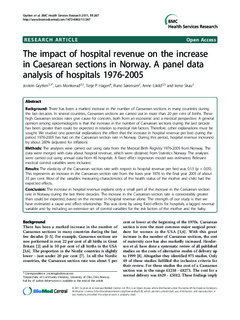| dc.description.abstract | Background: There has been a marked increase in the number of Caesarean sections in many countries during the last decades. In several countries, Caesarean sections are carried out in more than 20 per cent of births. These high Caesarean section rates give cause for concern, both from an economic and a medical perspective. A general opinion among epidemiologists is that the increase in the number of Caesarean sections during the last decade has been greater than could be expected in relation to medical risk factors. Therefore, other explanations must be sought. We studied one potential explanation; the effect that the increase in hospital revenue per bed during the period 1976-2005 has had on the Caesarean section rate in Norway. During this period, hospital revenue increased by about 260% (adjusted for inflation).
Methods: The analyses were carried out using data from the Medical Birth Registry 1976-2005 from Norway. The data were merged with data about hospital revenue, which were obtained from Statistics Norway. The analyses were carried out using annual data from 46 hospitals. A fixed effect regression model was estimated. Relevant medical control variables were included.
Results: The elasticity of the Caesarean section rate with respect to hospital revenue per bed was 0.13 (p < 0.05). This represents an increase in the Caesarean section rate from the basis year 1976 to the final year 2005 of about 35 per cent. Most of the variables measuring characteristics of the health status of the mother and child had the expected effects.
Conclusion: The increase in hospital revenue explains only a small part of the increase in the Caesarean section rate in Norway during the last three decades. The increase in the Caesarean section rate is considerably greater than could be expected, based on the increase in hospital revenue alone. The strength of our study is that we have estimated a cause and effect relationship. This was done by using fixed effects for hospitals, a lagged revenue
variable and by including an extensive set of control variables for the risk factors of the mother and the baby. | no_NO |
